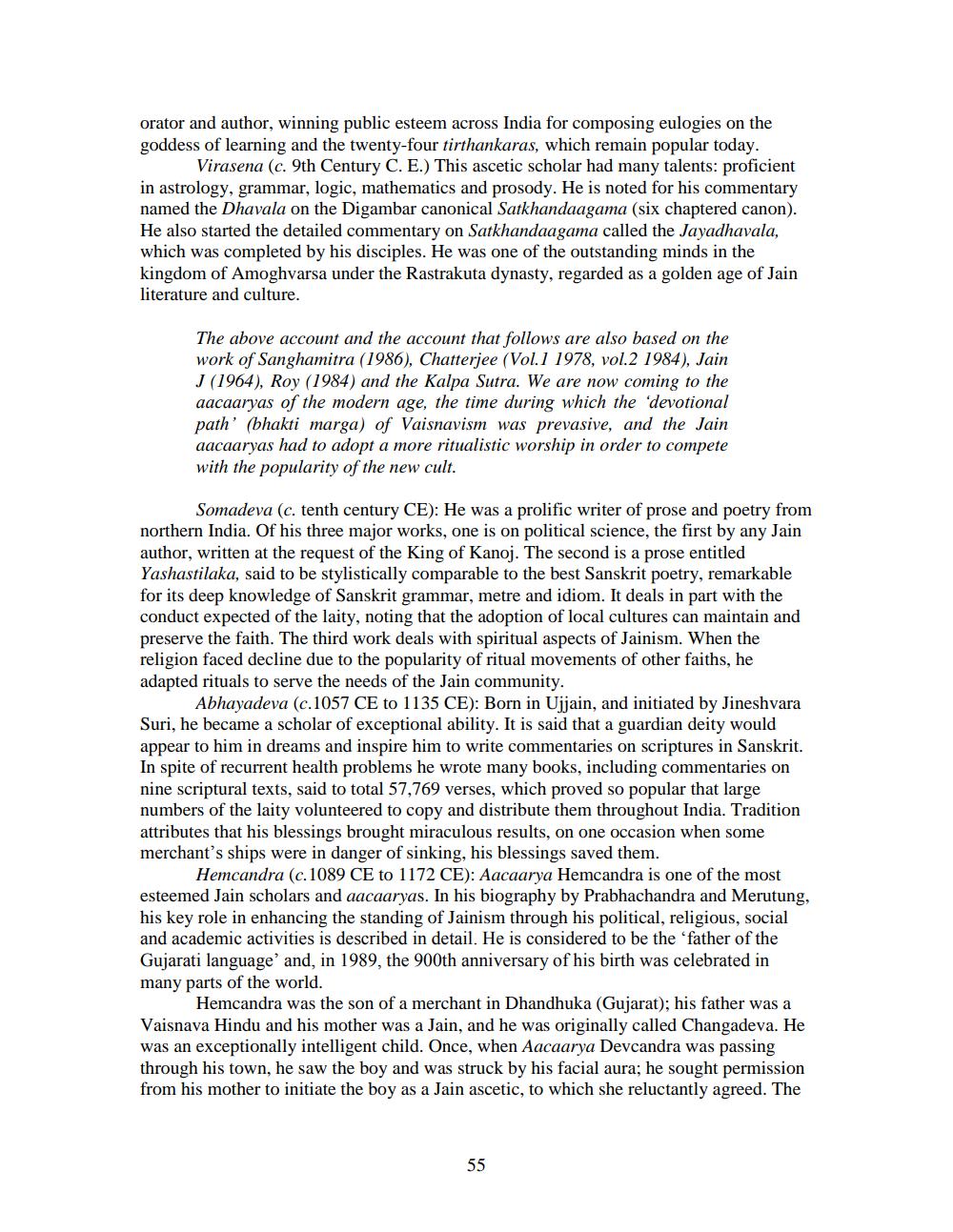________________
orator and author, winning public esteem across India for composing eulogies on the goddess of learning and the twenty-four tirthankaras, which remain popular today.
Virasena (c. 9th Century C. E.) This ascetic scholar had many talents: proficient in astrology, grammar, logic, mathematics and prosody. He is noted for his commentary named the Dhavala on the Digambar canonical Satkhandaagama (six chaptered canon). He also started the detailed commentary on Satkhandaagama called the Jayadhavala, which was completed by his disciples. He was one of the outstanding minds in the kingdom of Amoghvarsa under the Rastrakuta dynasty, regarded as a golden age of Jain literature and culture.
The above account and the account that follows are also based on the work of Sanghamitra (1986), Chatterjee (Vol.1 1978, vol.2 1984), Jain J (1964), Roy (1984) and the Kalpa Sutra. We are now coming to the aacaaryas of the modern age, the time during which the 'devotional path' (bhakti marga) of Vaisnavism was prevasive, and the Jain aacaaryas had to adopt a more ritualistic worship in order to compete with the popularity of the new cult.
Somadeva (c. tenth century CE): He was a prolific writer of prose and poetry from northern India. Of his three major works, one is on political science, the first by any Jain author, written at the request of the King of Kanoj. The second is a prose entitled Yashastilaka, said to be stylistically comparable to the best Sanskrit poetry, remarkable for its deep knowledge of Sanskrit grammar, metre and idiom. It deals in part with the conduct expected of the laity, noting that the adoption of local cultures can maintain and preserve the faith. The third work deals with spiritual aspects of Jainism. When the religion faced decline due to the popularity of ritual movements of other faiths, he adapted rituals to serve the needs of the Jain community.
Abhayadeva (c.1057 CE to 1135 CE): Born in Ujjain, and initiated by Jineshvara Suri, he became a scholar of exceptional ability. It is said that a guardian deity would appear to him in dreams and inspire him to write commentaries on scriptures in Sanskrit. In spite of recurrent health problems he wrote many books, including commentaries on nine scriptural texts, said to total 57,769 verses, which proved so popular that large numbers of the laity volunteered to copy and distribute them throughout India. Tradition attributes that his blessings brought miraculous results, on one occasion when some merchant's ships were in danger of sinking, his blessings saved them.
Hemcandra (c.1089 CE to 1172 CE): Aacaarya Hemcandra is one of the most esteemed Jain scholars and aacaaryas. In his biography by Prabhachandra and Merutung, his key role in enhancing the standing of Jainism through his political, religious, social and academic activities is described in detail. He is considered to be the father of the Gujarati language' and, in 1989, the 900th anniversary of his birth was celebrated in many parts of the world.
Hemcandra was the son of a merchant in Dhandhuka (Gujarat); his father was a Vaisnava Hindu and his mother was a Jain, and he was originally called Changadeva. He was an exceptionally intelligent child. Once, when Aacaarya Devcandra was passing through his town, he saw the boy and was struck by his facial aura; he sought permission from his mother to initiate the boy as a Jain ascetic, to which she reluctantly agreed. The
55




